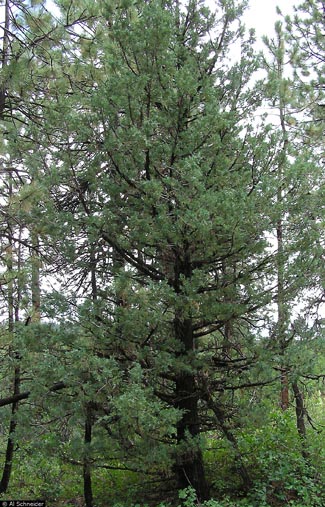Rocky Mountain Juniper

Common Name(s):
Rocky Mountain Juniper
Red Cedar
Scientific Name:
Juniperus scopulorum Sarg.
Scientific Name Synonyms:
None known
Symbol:
JUSC2
Description:
Life Span: Perennial
Origin: Native
Season: Evergreen
Growth Characteristics: Rocky Mountain juniper can be a shrub or small tree, growing 3 to 30 feet tall. It branches near the ground, and has more of a Christmas tree shape than Utah juniper. Rocky Mountain juniper pollinates April to May, juniper "berries" mature October to December of the second year following pollination. Reproduces from seed.
Flowers/Inflorescence: Male and female cones are on separate trees. The female cones are inconspicuous the first year, solitary at the tips of branchlets. The mature cones are berry-like, fleshy, gummy, bright blue to purplish, and covered with a whitish bloom that will wipe off.
Fruits/Seeds: Two seeds are contained within the "husk" of the cone. Seeds are about 1/8 inch long, pointed on one end with a small, dark mark on the other end.
Leaves: Opposite, scale-like, and small (about 1/16 to 1/8 inch long). On new growth and seedlings, the leaves are frequently elongated and awl-like. Leaf tips slightly overlap the base of the next leaves up the twig. They are pale to dark green in color.
Stems: Twigs are slender and scaly, being flattened at first, then becoming round. Bark is reddish-brown and shreddy. The wood of soft, light in weight, with reddish heartwood and a thick, light colored sapwood beneath the bark. The wood is desirable for making cedar chests and other decorative wood products.
Ecological Adaptions:
Rocky Mountain juniper is a dry, or more rarely, moist, subhumid plant which grows well on open, exposed bluffs, rocky points, or ridgetops, on southern exposures and in ravines or canyons. It is found between 5,000 and 9,000 feet elevation.
Soils: Most abundant on calcareous and somewhat alkaline soils.
Associated Species: Aspen, gambel oak, chokecherry, waterleaf, mixed conifer, and big sagebrush.
Uses and Management:
Rocky Mountain juniper provides food and cover for a number of wildlife species. It is used to some extent by elk, mule deer, whitetail deer, bighorn sheep, and antelope. Migratory birds, turkeys, and other upland game birds readily consume Rocky Mountain juniper "berries". The "berries" are also eaten by many species of small mammals. Rocky Mountain juniper is sometimes used by sheep and other domestic livestock, but is not a favored foliage plant, and may cause abortion.
American Indians ate the fruits raw or cooked, and used them as flavoring for meat and gin. Fruits and young shoots were boiled for tea; fruits were ground for mush and cakes. The wax from berries was used in candles. It is currently used as an ornamental, in shelterbelts, for fence posts, and fuel. It is reported to have insect repellent properties.

